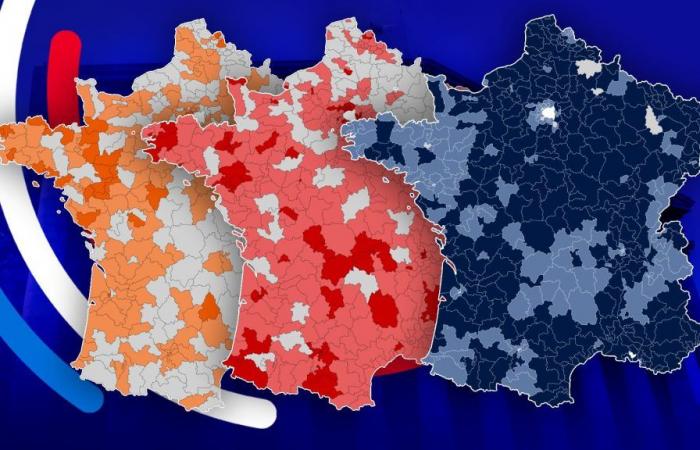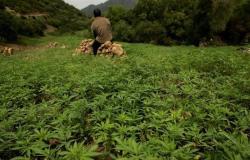The National Rally came first in the first round of the legislative elections this Sunday, June 30. But Jordan Bardella’s party is not yet guaranteed to obtain an absolute majority in the National Assembly. Summary of the issues in cards.
Towards an absolute majority for the National Rally and its allies? The far-right party appears to be in a strong position after the first round of early legislative elections, which were held this Sunday, June 30. It could obtain 255 to 295 seats in the National Assembly, according to our Elabe projection for BFMTV, RMC and La Tribune on Sunday – the threshold for an absolute majority being set at 289 deputies.
>> 2024 legislative elections: the complete results
Enough, therefore, potentially, to send Jordan Bardella to Matignon. But the vote is far from over: a second round will take place in many constituencies on Sunday July 7. Before that, BFMTV offers you 5 maps to better understand the results of this first round and identify the issues of the second.
• The RN records significant progress
An inexorable progression? In the 2012 legislative elections, the Rassemblement bleu Marine obtained only two elected representatives to the National Assembly: Marion Maréchal-Le Pen, in Vaucluse, and Gilbert Collard, in Gard. Five years later, in 2017, the National Front sent 8 deputies to the National Assembly. In 2022, the National Rally garnered a total of 89 elected officials. And now he might be able to have more than 250 according to our projection.
The map below shows how the RN has established itself, legislative election after legislative election since 2012. For each election, the constituencies in which the candidate labelled FN or RN came out on top in the first round or achieved a sufficient score to qualify for the second round appear in blue.
The far-right party’s performance is “spectacular”, according to the Ipsos institutewhich published a survey for France Télévisions and Public Sénat that details “a new, diversified and expanded RN electorate”. “Just like that of the New Popular Front, which is resisting and even making significant progress among young people”, notes the institute.
The National Rally and its allies outperformed its traditional supporters, “but in proportions which had never been measured in a first round”: for example, it received 57% of votes among workers, or 12 points more than in the 2022 legislative elections. Long considered a vote for “popular” France, the party of Marine Le Pen and Jordan Bardella also seems to have convinced the wealthiest voters.
Indeed, respondents with an income level above 3,000 euros say they voted 32% for the RN and its allies, far ahead of the left (26%) and Ensemble (23%). For comparison, in 2022, the balance of power in this social category was completely reversed: the RN obtained 15%, the presidential camp 28% and the left 22%.
• The left resists
In 2022, the left left united under the banner of the New Ecological and Social Popular Union, abbreviated as Nupes. Together, La France Insoumise, the Socialist Party, Europe Écologie and the Communist Party became the leading opposition force in the hemicycle of the National Assembly with 131 elected members.
And in 2024? The left, this time united with the New Popular Front, should obtain 120 to 140 elected officials, according to our Elabe projection for BFMTV, RMC and La Tribune on Sunday – more or less the same level as before the dissolution.
The map below shows how the union of the left has fared in relation to 2022. For each ballot, the constituencies appear in red in which the candidate labeled Nupes or NFP came first in the first round or achieved a sufficient score to qualify for the second round.
• Macronie is collapsing
In 2017, La République en Marche won more than 300 seats in the legislative elections and changed the face of the National Assembly by exploding the old left-right divide. In 2024? Macronie is about to switch to opposition at the Palais-Bourbon. The Ensemble candidates came in third place nationally, with 20.04% of the vote according to the complete results published by the Ministry of the Interior.
The coalition would obtain 90 to 125 deputies, according to our Elabe projection for BFMTV, RMC and La Tribune on Sunday – half as many as before the dissolution.
The map below shows how Macronist candidates have gradually disappeared from the landscape since 2017. For each election, the constituencies in which the candidate labelled Ensemble came out on top in the first round or achieved a sufficient score to qualify for the second round appear in orange.
• 76 deputies elected in the first round
In 76 constituencies, it will not be necessary to go to the polls next Sunday: one of the candidates was elected in the first round this Sunday, June 30, by collecting both a majority of the votes cast, but also by obtaining a number of votes equivalent to at least 25% of those registered.
Among these deputies in the first round, 39 come from the ranks of the National Rally or its allies. The latter are performing particularly well in their strongholds in the North-East and South-East of France, like Thierry Frappé, outgoing MP and winner with 60.6% of the votes in the 10th constituency of the North.
The New Popular Front can also count on 32 deputies from this Sunday evening, notably elected in Île-de-France. In the 6th constituency of Seine-Saint-Denis, the outgoing deputy, the rebellious Bastien Lachaud, thus collected 71.43% of the votes.
• More than 300 possible triangular races in the second round
What will happen in the other constituencies? Given the high turnout recorded in this first round, more than 300 three-way races are possible, according to BFMTV’s count – two thirds of them pitting the RN against the New Popular Front and the presidential coalition Ensemble. Five four-way races are even possible.
But this configuration is for the moment only theoretical: the candidates qualified for the second round have until Tuesday 6 p.m. to declare their intentions. And either present themselves again to the electorate’s votes, or withdraw.
On the left, the call for a blockade against the National Rally seems to be a consensus. In the presidential camp, Emmanuel Macron has called for “a broad, clearly democratic and republican gathering”, but its precise contours remain to be defined.






